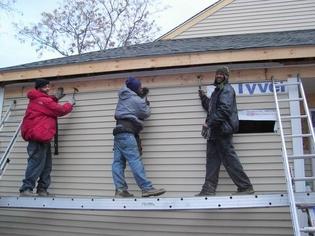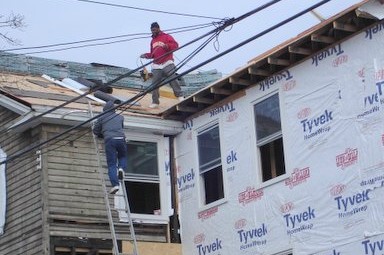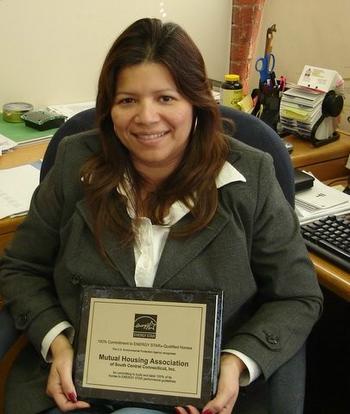 These guys are filling a Fair Haven block with new homes that are not only affordable — but easy on the environment, too.
These guys are filling a Fair Haven block with new homes that are not only affordable — but easy on the environment, too.
Although the housing under construction near Grand Avenue between Poplar and Ferry streets may not look special to the casual observer, it is special. The affordable housing development being built by the Mutual Housing Association has a green tinge to it.
 Sixteen of the 24 rental units are rehabs, while eight are new construction using eco-friendly materials that include recycled items or those normally considered waste products, such as scrap lumber. For example, insulation is cotton or mineral wool instead of fiberglass; flooring is linoleum instead of plastic or vinyl tiles; paint is water-based to eliminate the volatile organic compounds (VOCs) found in oil-based paint.
Sixteen of the 24 rental units are rehabs, while eight are new construction using eco-friendly materials that include recycled items or those normally considered waste products, such as scrap lumber. For example, insulation is cotton or mineral wool instead of fiberglass; flooring is linoleum instead of plastic or vinyl tiles; paint is water-based to eliminate the volatile organic compounds (VOCs) found in oil-based paint.
And all 24 units will have only Energy Star appliances, which reduce energy demand. Mutual Housing even got a plaque to prove it.
 Executive director Seila Mosquera (in photo) said the project is using green materials as much as possible in all the units, as well as energy efficiency.
Executive director Seila Mosquera (in photo) said the project is using green materials as much as possible in all the units, as well as energy efficiency.
During a visit last Friday to the building site, this reporter saw workers toiling on the new community building as well as several existing buildings that are being re-designed to fit into the project.
“The green units will be certified under LEED —” Leadership in Energy Efficient Design —” which has established criteria for certifying buildings depending on the number of —Àúgreen’ elements,” said Regina Winters, an architect and former director of real estate development at Mutual Housing who helped plan the project. “Some of those elements include sustainable design, using materials that are easily replenished and won’t deplete natural resources; site design, incorporating reuse of materials, such as water, and energy-efficient construction equipment; and energy conservation through the use of Energy Star appliances.
“There are only six —Àúgreen’ affordable housing developments in the country,” Winters says. “They cost more because local builders aren’t used to the techniques and equipment used in this type of building. If we can train them in the use of these new materials and methods, then costs will come down.”
Mosquera says seven of the units will be ready by April, the rest by July. The apartments will have from one to four bedrooms, and families are eligible whose income is 25 percent to 80 percent of the region’s median family income, which is $73,450. So, for example, a family earning the lowest income would pay $242 a month for a two-bedroom unit, while a family earning half the region’s median income would pay $662 for the same unit. And they’ll save money on energy costs, to boot.

Since they are doing so well on this project, perhaps as their next task we could have them work on the Ferry Street Bridge. The couldn't do a worse job than the DeStefano administration; any work on the bridge would be better than the current administration's sad history of dropping the ball on this project. Perhaps the people of Fair Haven should remind the mayor that they too can vote in the elections for state governor.
<p>
BTW, there are very few oil-based paints used in construction these days; latex-based paint is less expensive and easier to use and clean up.
<p>
<i>...eight are new construction using eco-friendly materials that include recycled...</i>
<p>
One need's to make a careful evaluation of whether any material, recycled or "new", is "eco-friendly". That evaluation must include information regarding the energy required in manufacturing the product (and how that energy was produced), the energy involved transporting the product, etc. The best planning even includes consideration of the "end of life" and safe disposal of the product. It can be quite difficult to get the information required to make an informed decision about such products, so people instead often rely upon a more shallow evaluation provided by a "green" sticker on the product. The potential problem is that those "green" stickers/names are brought to you by the same dishonest marketing geniuses that created the "Lite" names for food products.
</p></p></p>